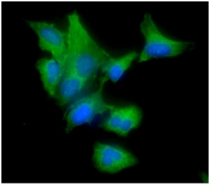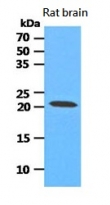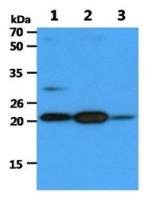ARG57106
anti-Caveolin 1 antibody [4C1]
anti-Caveolin 1 antibody [4C1] for ICC/IF,Western blot and Human,Rat
Endosome Marker antibody
Overview
| Product Description | Mouse Monoclonal antibody [4C1] recognizes Caveolin 1 |
|---|---|
| Tested Reactivity | Hu, Rat |
| Tested Application | ICC/IF, WB |
| Host | Mouse |
| Clonality | Monoclonal |
| Clone | 4C1 |
| Isotype | IgG2b, kappa |
| Target Name | Caveolin 1 |
| Antigen Species | Human |
| Immunogen | Recombinant fragment around aa. 1-104 of Human Caveolin 1. |
| Conjugation | Un-conjugated |
| Alternate Names | CGL3; LCCNS; PPH3; MSTP085; VIP21; BSCL3; Caveolin-1 |
Application Instructions
| Application Suggestion |
|
||||||
|---|---|---|---|---|---|---|---|
| Application Note | * The dilutions indicate recommended starting dilutions and the optimal dilutions or concentrations should be determined by the scientist. |
Properties
| Form | Liquid |
|---|---|
| Purification | Purification with Protein G. |
| Buffer | PBS (pH 7.4), 0.02% Sodium azide and 10% Glycerol. |
| Preservative | 0.02% Sodium azide |
| Stabilizer | 10% Glycerol |
| Concentration | 1 mg/ml |
| Storage Instruction | For continuous use, store undiluted antibody at 2-8°C for up to a week. For long-term storage, aliquot and store at -20°C. Storage in frost free freezers is not recommended. Avoid repeated freeze/thaw cycles. Suggest spin the vial prior to opening. The antibody solution should be gently mixed before use. |
| Note | For laboratory research only, not for drug, diagnostic or other use. |
Bioinformation
| Database Links | |
|---|---|
| Gene Symbol | CAV1 |
| Gene Full Name | caveolin 1, caveolae protein, 22kDa |
| Background | The scaffolding protein encoded by this gene is the main component of the caveolae plasma membranes found in most cell types. The protein links integrin subunits to the tyrosine kinase FYN, an initiating step in coupling integrins to the Ras-ERK pathway and promoting cell cycle progression. The gene is a tumor suppressor gene candidate and a negative regulator of the Ras-p42/44 mitogen-activated kinase cascade. Caveolin 1 and caveolin 2 are located next to each other on chromosome 7 and express colocalizing proteins that form a stable hetero-oligomeric complex. Mutations in this gene have been associated with Berardinelli-Seip congenital lipodystrophy. Alternatively spliced transcripts encode alpha and beta isoforms of caveolin 1.[provided by RefSeq, Mar 2010] |
| Function | May act as a scaffolding protein within caveolar membranes. Interacts directly with G-protein alpha subunits and can functionally regulate their activity (By similarity). Involved in the costimulatory signal essential for T-cell receptor (TCR)-mediated T-cell activation. Its binding to DPP4 induces T-cell proliferation and NF-kappa-B activation in a T-cell receptor/CD3-dependent manner. Recruits CTNNB1 to caveolar membranes and may regulate CTNNB1-mediated signaling through the Wnt pathway. [UniProt] |
| Research Area | Endosome Marker antibody |
| Calculated MW | 20 kDa |
| PTM | The initiator methionine for isoform 2 is removed during or just after translation. The new N-terminal amino acid is then N-acetylated. Phosphorylated at Tyr-14 by ABL1 in response to oxidative stress. |
Images (3) Click the Picture to Zoom In
-
ARG57106 anti-Caveolin 1 antibody [4C1] ICC/IF image
Immunofluorescence: A549 cells line stained with ARG57106 anti-Caveolin 1 antibody [4C1] at 1:100 (green).
DAPI (Blue) for nucleus staining.
-
ARG57106 anti-Caveolin 1 antibody [4C1] WB image
Western blot: 40 µg of Rat brain lysate stained with ARG57106 anti-Caveolin 1 antibody [4C1] at 1:1000.
-
ARG57106 anti-Caveolin 1 antibody [4C1] WB image
Western blot: 40 µg of 1) Mouse brain, 2) Mouse heart, and 3) A431 cell lysate stained with ARG57106 anti-Caveolin 1 antibody [4C1] at 1:1000.








